Communication and Interaction Design degree programmes at The Design Village (TDV) emphasize on the creative and technological abilities to prepare designers who work across traditional and modern mediums, applying themselves to create print media as well as interactive digital products, systems and services. The programmes offer students an industry-centric blend of skillsets, critical to excel in the competitive and rapidly evolving communication and interaction design industry. The education at TDV aims to prepare graduates for the future, and the courses under these programmes are run with an inherent focus on Branding and New Media Design.
B.Des (Hons.)
More about 4-year
undergraduate programme
M.Des
More about 2-year
postgraduate programme

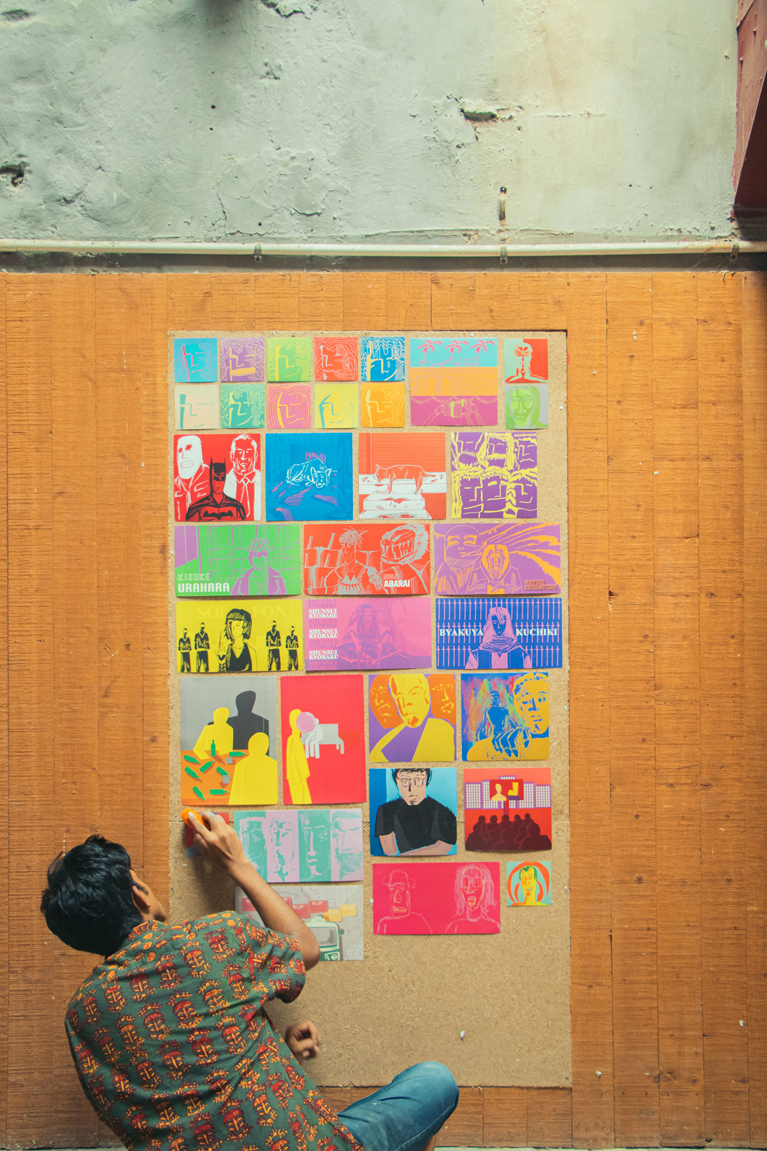
(HIGHLIGHTS)
Why choose TDV FOR
Communication & Interaction Design?
Branding and New Media
Communication and Interaction education at TDV prepares graduates to navigate the transitions being experienced by the industry. This intent is deeply rooted in the curriculum with a focus on two domains: Brand Design, a profession of creating the identity of an entity, and New Media, a term used to describe ways in which we consume and create content such as digital technologies, artificial intelligence, UI/UX etc.
Industry-centric Ecosystem
With a Forbes’ award-winning campus located in the heart of Noida’s manufacturing industry, TDV’s Fashion & Textile Design programmes offer students the perfect ecosystem to experience world-class education, with access to the industry’s most prominent professionals including Anavila Misra, Rakesh Thakore, Varun Bahl etc., and the opportunity to work on 10+ real world projects.
Placements
TDV’s Communication and Interaction Design programme has strong ties with multi-national companies, established studios and admirable startups, enabling students to get their foot inside some of the most inaccessible industry doors across the world, including Adobe, Deloitte, Freecharge, Google, Hindustan Times, IBM, Jio, PhonePe, Porter, Purpose, Tata Elxsi and Wharton India.
(PLACEMENTS)
Work for
Leading Brands
Industry Relations team at TDV works closely with students to help them secure internships and placements from a diverse and prestigious array of sources, while ensuring that their personal career goals are met.


Neethu TP
Researcher,
Freecharge, Mumbai


Jugaadh Lamba
Executive Graphic Designer,
Hero Enterprise, Goa

Harshit Gupta
Hindustan Times, New Delhi
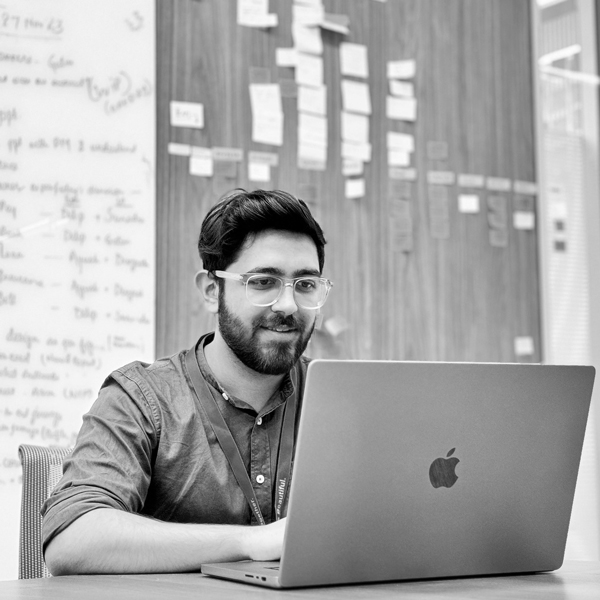

Gatim Sachdeva
Jio Platforms Limited, Mumbai


Rochak Kumar Ritam,
Porter, Bengaluru


Akarsh Goyal
Innovaccer, Noida


Ayushi Srivastava
SilverGenie, Gurugram


Kiran H Nath
Tata Elxsi, Bengaluru
(CAREER PATHWAYS)
FORGE a PATH that
reflects you
Discover the diverse paths your design education can lead to. Whether you're driven by creativity, strategy, storytelling, or systems, this is where your journey begins to take shape.

UI / UX Design
Design intuitive, human-centred digital experiences. UI/UX designers shape how we interact with technology- crafting seamless & engaging journies.

Graphic Design
Communicate ideas through image, type, and visual systems. Graphic designers build narratives and identities across print, digital, and spatial media.

Animation & VFX Design
Bring stories to life through motion and illusion. Animators and VFX artists create dynamic, immersive visuals across communications.

Film & Photography
Capture the world and reframe how we see it. Filmmakers and photographers craft compelling visual narratives that inform, influence, and inspire.
(AWARDS)
Get Globally
Recognized


Aman Pathak, Delhi
AapkaSaathi, Systemic Intervention in Reception of Public Healthcare, Winner of Good Intervention 2024 Competition, Parsons School of Design (New York, USA)

(Real-world Projects)
Industry projects are a part of TDV classroom, giving students an in-depth, hands-on experience of how organizations approach actual design problems, manage clients, and deliver final products in the market.
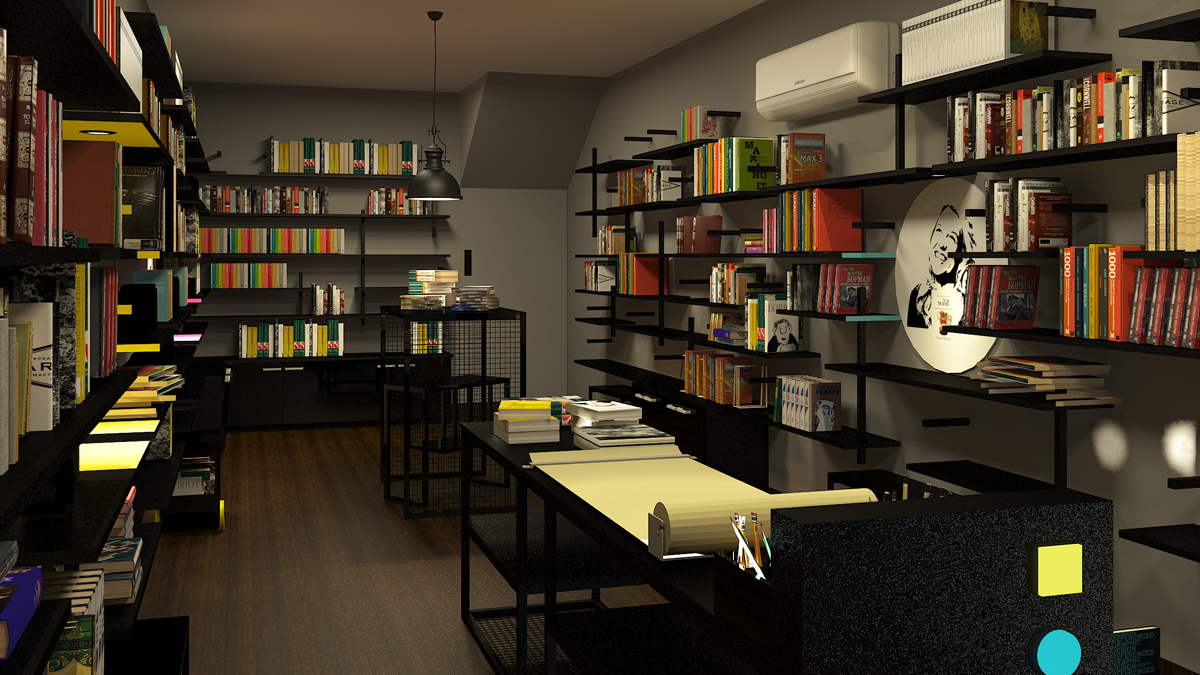

Waste to Wonder, 2024, Embassy of the Kingdom of the Netherlands
Revitalise the Holland Corporate Gift Collection to reflect the current visual branding of the embassy of Kingdoms of Netherlands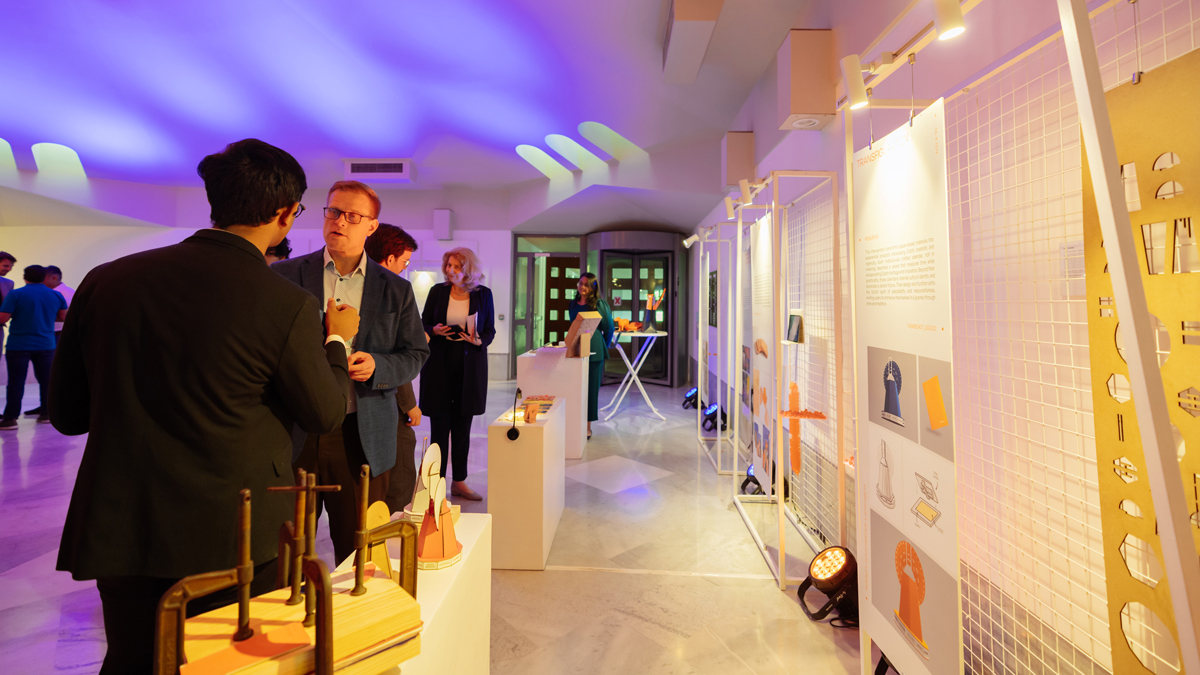

Aftermath Camp, 2024, Harvard Kennedy School
Publication design for Alumni of Harvard Kennedy School

Brand and Context Integration, 2024, Indiahikes
Propose strategic solutions to bring values of brand and context across Indiahikes community basecamps in the Himalayas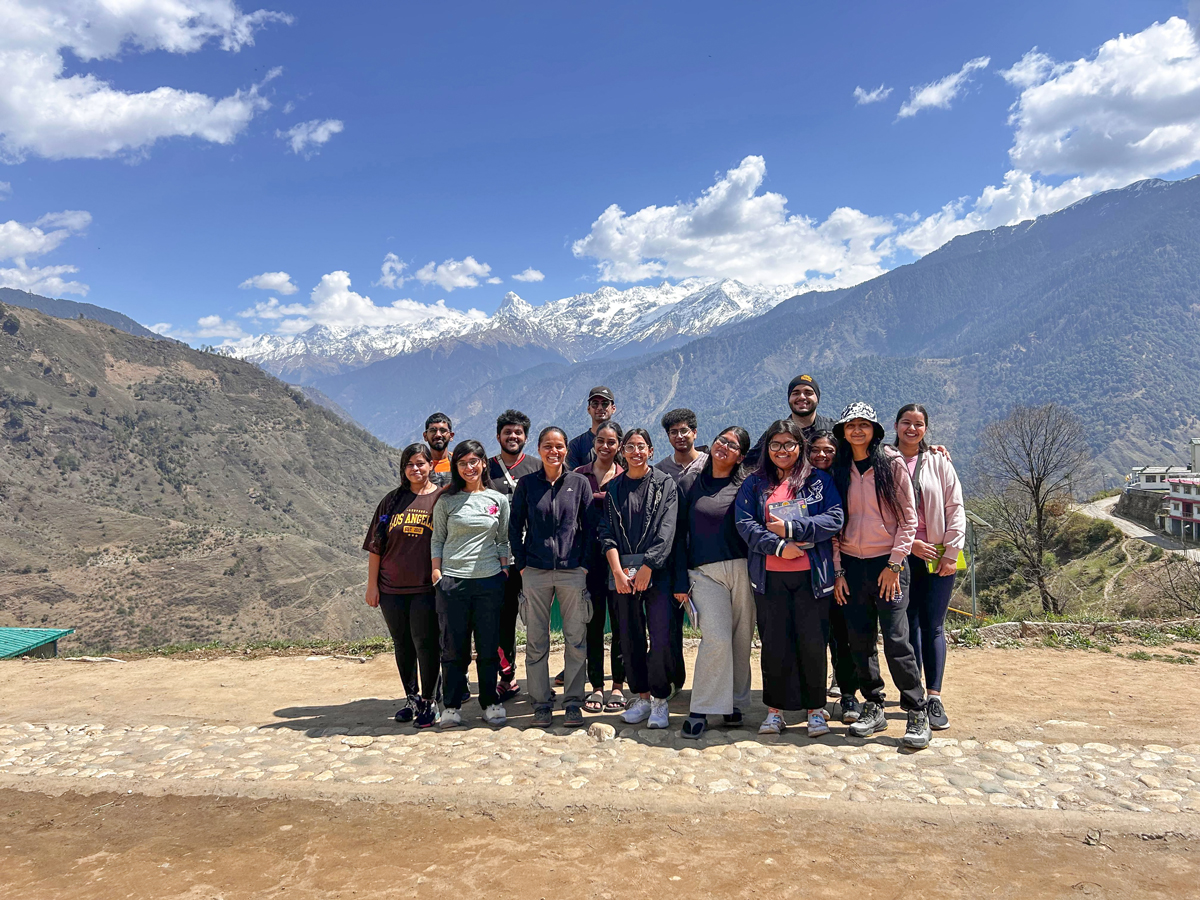

Empowering Eco-Champions, 2024, Mynzo Carbon
Develop an engagement approach through storytelling, simulation and gamification to nudge towards behavioral change and ultimately towards a Net Zero Future
(STUDENT WORK)
Innovate in
THE CLASSROOM
Communication and Interaction Design students at TDV take up classroom projects that visualise how users interact, communicate, and connect in a rapidly evolving digital landscape.
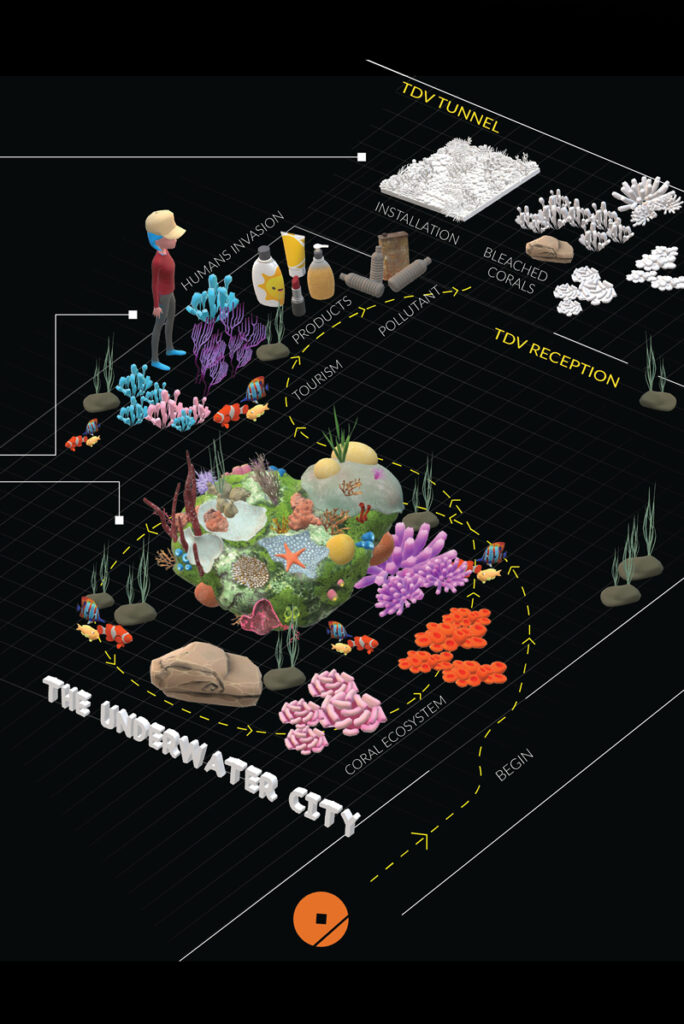
Fading cities of underwater
An immersive experience integrating Augmented Reality and 3d projection mapping to bring awareness about bleaching of corals.
Himanshu Tiwari
2022
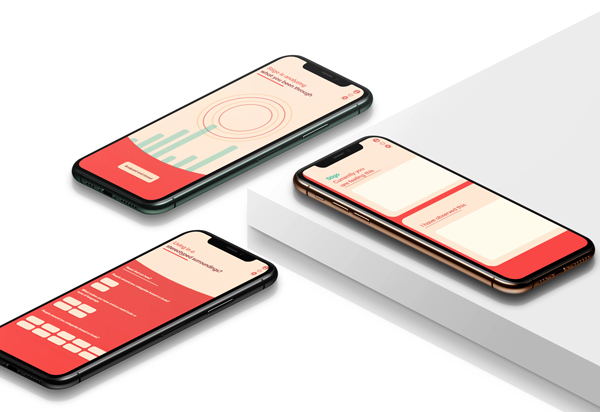
Breaking Stigmas with Stigo
Intervention to de-stigmatise work culture for people regardless of gender and to promote body positivity.
Radhika Thapar
2021

Talk-a-block
Building a game for children with ADHD to aid them in initiating conversations among peers.
Amrita Chatterjee
2024

Catch-Catch
A campaign to help people understand the intensity of waste production in the world and provide solutions.
Saansh Arora, Yogita Pahuja, Aman Pathak
2024

I am Dyslexia
A dyslexic-friendly digital library translating words into diverse experiences, expanding accessibility through use of algorithms.
Kiran H Nath
2021
(EXPOSURE)
Kickstart Making at world's
finest Professional Workshop

MAKE Abu Dhabi is a community-based space for creative individuals that is part workshop, lab, studio and garage with a wide range of professional-grade machinery, tools and classes covering the technical, the mechanical and the tactile elements of engineering, making and design. TDV students, in their first year of the programme, access an all-inclusive immersion working at Make Abu Dhabi that widens their horizon, preparing them to imagine and innovate the future.

(FACILITIES)
Access Industry-Grade ExoLab Network

MacLab
Technologically-advanced Computing Lab with a capacity of 15 students, fulfilling any and every need of communication and interaction designers.
(MASTERS)
Learn from
Industry Masters


Siddharth Bathla
Professor of Practice
Director, Design Factory India
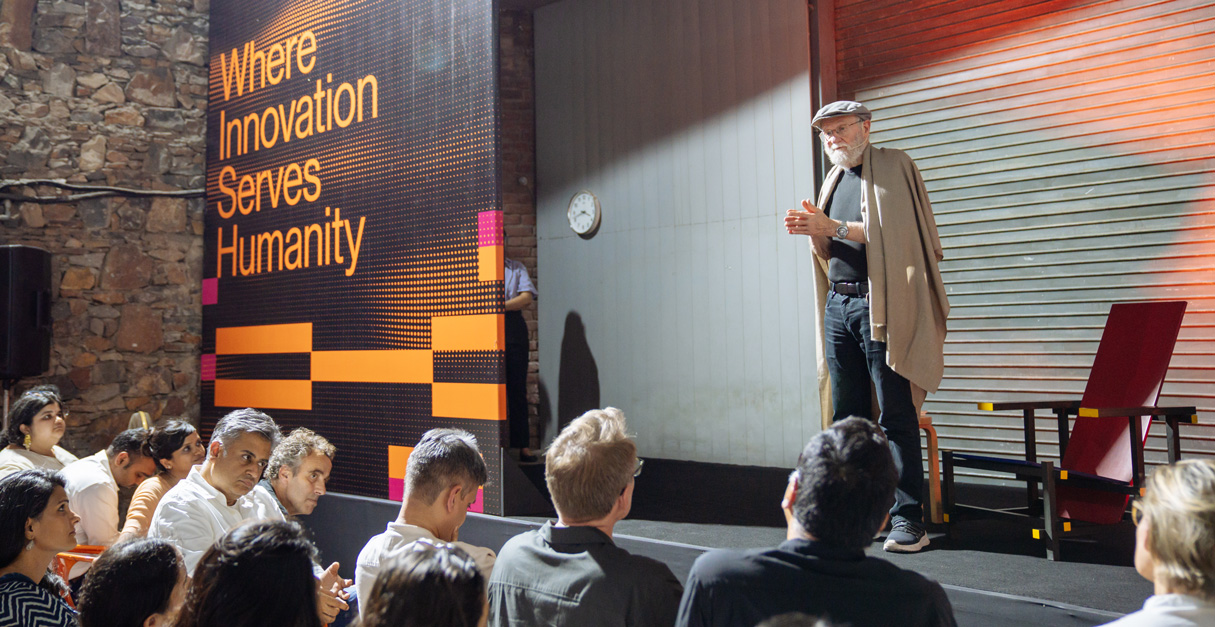

Don Norman
Former Vice President of Advanced Technology, Apple
Where Innovation Serves Humanity, 2024
(FACULTY)
PROGRAMME FACULTY

Pritesh Maru
Programme Head
B Des Visual Communication | National Institute of Design, Ahmedabad | 2013

Anwaar Alam
Programme Coordinator
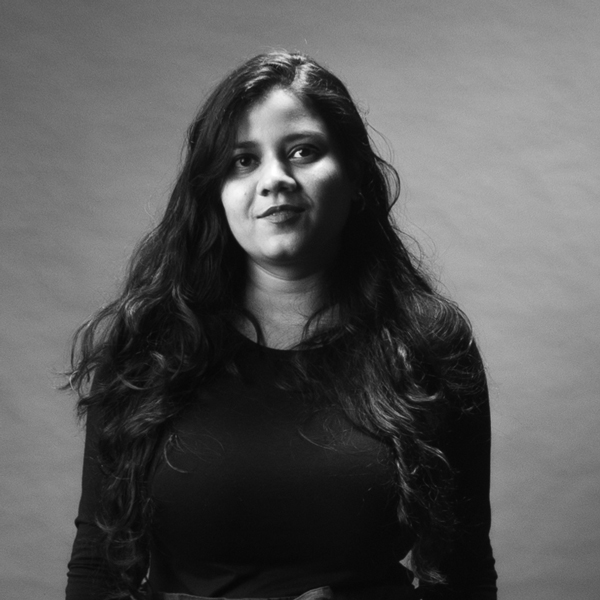
Abhilasha Prajapati
Faculty

Nikhil Tailang
Faculty

Samyak Jain
Faculty
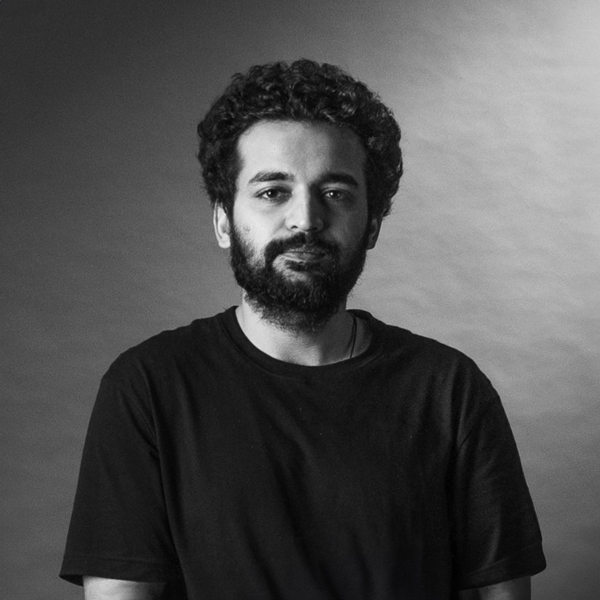
Tarique Ahamed
Faculty
(FAQs)
FREQUENTLY
ASKED
QUESTIONS
Communication & Interaction Design at TDV
1) What is Communication and Interaction Design?
1) Communication and Interaction Design is a multidisciplinary field that focuses on creating meaningful and effective interactions between people and products, services, or environments. It involves designing experiences that are intuitive, engaging, and enjoyable for users. Communication and Interaction Designers use a combination of visual design, user research, and technology to create products and services that meet the needs and expectations of their target audience.
2) Why study Communication and Interaction Design?
2) Communication and Interaction Design is a dynamic field that bridges the gap between visual storytelling and user-centered digital experiences. By pursuing this interdisciplinary programme, you’ll gain expertise in two crucial areas that shape our modern world:
Visual Communication
• Learn to craft compelling visual narratives that resonate with diverse audiences
• Develop skills in graphic design, branding, and multimedia storytelling
• Understand how to effectively convey complex ideas through visual mediums
Interaction Design
• Master the art of creating intuitive, user-friendly digital interfaces
• Explore the principles of user experience (UX) and user interface (UI) design
• Gain hands-on experience with prototyping tools and usability testing methods
By combining these two disciplines, you’ll be uniquely positioned to:
1) Shape the digital landscape: As businesses and services increasingly move online, professionals who understand both visual communication and interaction design are in high demand.
2) Drive innovation: Learn to create cutting-edge designs that not only look appealing but also function seamlessly, enhancing user engagement and satisfaction.
3) Solve complex problems: Develop critical thinking skills to address real-world challenges through effective communication and user-centered design solutions.
4) Embrace versatility: Gain a diverse skill set that opens doors to various career paths in design, technology, marketing, and beyond.
5) Stay ahead of the curve: Keep pace with rapidly evolving technologies and design trends, ensuring your skills remain relevant in a fast-changing job market.
6) Make a meaningful impact: Create designs that not only captivate but also improve people’s lives by enhancing accessibility and user experience.
At TDV, you’ll benefit from a curriculum that balances theory and practice, industry-experienced faculty, state-of-the-art facilities, and opportunities to work on real-world projects to become a well-rounded design professional capable of shaping the future of visual and digital communication.
3) What does Communication and Interaction Design programme cover?
3) A Communication and Interaction Design program covers a wide range of topics aimed at creating effective and engaging experiences for users across various digital and physical platforms. The program typically combines elements of user experience (UX), user interface (UI) design, communication theory, and human-computer interaction (HCI). Here’s an overview of the key areas that are often covered:
1) Design Fundamentals
Visual Design Principles: Focus on color theory, typography, layout, and composition to create visually appealing designs.
Branding and Identity: Understanding how to design visual elements that communicate brand values and identity.
2) Communication Theory
Media and Messaging: How messages are crafted and communicated effectively through different mediums.
Storytelling and Narrative Design: Techniques for telling engaging stories through visuals and interactive elements.
Information Design: Structuring and presenting complex information in a way that is easy to understand and use.
3) User Experience (UX) Design
User Research: Methods for understanding user needs, behaviors, and pain points (interviews, surveys, personas).
Usability Testing: Evaluating designs through user testing to ensure they are intuitive and user-friendly.
User-Centered Design: Designing with the user in mind, ensuring accessibility and satisfaction.
4) Interaction Design
Prototyping and Wireframing: Creating blueprints for digital products, focusing on user flow and functionality.
Human-Computer Interaction (HCI): The study of how users interact with computers and digital interfaces.
Micro-Interactions: Designing small, engaging animations and feedback mechanisms (like button clicks, notifications).
Emerging Technologies: Interaction design for AR/VR, voice interfaces, wearables, and other cutting-edge technologies.
5) User Interface (UI) Design
Interface Design: Creating visually appealing and easy-to-navigate interfaces for websites, apps, and software.
Responsive Design: Ensuring designs work seamlessly across different devices and screen sizes.
Design Systems: Building consistent visual and interaction guidelines that can be reused across multiple projects.
6) Prototyping and Tools
Design Software: Mastering tools like Figma, Adobe XD, Sketch, or InVision for prototyping and visual design.
Interactive Prototyping: Creating interactive mockups to demonstrate functionality before development.
Coding for Designers: Basic understanding of HTML, CSS, and JavaScript to collaborate with developers and bring designs to life.
7) Communication and Collaboration
Working with Teams: Collaboration with developers, marketers, and other designers in a project environment.
Client Communication: Presenting design concepts and receiving feedback from clients and stakeholders.
8) Design Research and Strategy
Design Thinking: Applying creative problem-solving techniques to design challenges.
Ethnography and Cultural Research: Understanding the social and cultural contexts of design.
Service Design: Creating holistic solutions that account for both user experiences and business needs.
9) Ethics and Accessibility
Design for Accessibility: Ensuring digital experiences are inclusive for people with disabilities.
Ethical Design: Considering the societal impact of design decisions, such as privacy, inclusivity, and sustainability.
10) Portfolio Development
Building a Design Portfolio: Creating a portfolio that showcases projects, including UX research, wireframes, prototypes, and final designs.
Capstone Project: Often, students work on a comprehensive final project to apply their skills to real-world challenges.
4) Do I need to be good in art or drawing to study Communication and Interaction Design?
4) No, you don’t necessarily need to be good at traditional art or drawing to study Communication and Interaction Design. While having basic sketching skills can be helpful for visualizing ideas, the field primarily focuses on problem-solving, understanding user behavior, and creating effective user experiences through digital tools.
Therefore having a visualization skills and a willingness to explore and develop your creative skills is important. The programme will challenge you to:
– Visualize and communicate ideas effectively
– Understand and apply visual design principles
– Develop an eye for aesthetics and user-friendly design
If you’re passionate about design and technology, and you’re willing to learn and practice, you can succeed in Communication and Interaction Design, regardless of your initial artistic abilities. Our programme at The Design Village is designed to nurture your creativity and help you grow as a designer, starting from wherever your current skill level may be
5) Why choose The Design Village for Communication and Interaction Design?
5) Choosing The Design Village (TDV) for a program in Communication and Interaction Design can be an excellent decision for several reasons:
1) Interdisciplinary Approach
TDV focuses on interdisciplinary design education, integrating various fields of design, which is critical for Communication and Interaction Design. The program emphasizes the merging of technology, communication, and creative problem-solving, equipping students with a holistic understanding of how design impacts human interaction across different platforms.
2) Global Exposure
TDV has strong global connections with international design schools, professionals, and thought leaders. These partnerships provide students with opportunities for global internships, exchange programs, and exposure to international design trends—key for staying ahead in the fast-evolving fields of UX/UI and interaction design.
3) Industry-Relevant Curriculum
The curriculum at TDV is designed to stay relevant with industry needs, blending theoretical knowledge with practical, hands-on learning. Students work on real-world projects, which helps them build a strong portfolio by the time they graduate. TDV emphasizes learning through collaboration with industry professionals, preparing students for the demands of the professional world.
4) Focus on User-Centered Design
Communication and Interaction Design at TDV focuses heavily on user-centered design principles. This prepares students to create designs that are not only visually appealing but also intuitive and functional. User research, prototyping, and usability testing are core parts of the program, helping students understand how to solve real-world problems through design.
5) State-of-the-Art Campus and Infrastructure
TDV provides a creative and collaborative environment, with modern design studios, workshops, and labs equipped with the latest technology and software. This helps students stay at the cutting edge of the design process, from ideation to prototyping and execution.
6) Mentorship by Experienced Faculty
The faculty at TDV consists of experienced designers, industry professionals, and educators who provide one-on-one mentorship. This guidance is crucial for personal and professional growth, helping students develop both technical skills and creative confidence.
7) Focus on Design Thinking and Innovation
TDV’s teaching philosophy emphasizes design thinking, encouraging students to think creatively, empathize with users, and come up with innovative solutions. This methodology aligns perfectly with the needs of communication and interaction design, where innovation is key to creating impactful user experiences.
8) Community and Collaborative Culture
TDV fosters a strong sense of community and collaboration among students and faculty. The school encourages cross-disciplinary projects and learning, where students from different design backgrounds can work together, enriching the overall learning experience.
9) Entrepreneurial Opportunities
TDV encourages an entrepreneurial mindset. Students are not just trained to become designers but also innovators and thought leaders who can start their own design ventures. With guidance in areas like business, marketing, and intellectual property, students are equipped to turn their ideas into successful projects or businesses.
10) Sustainability and Ethical Design
TDV places a strong emphasis on sustainable and ethical design practices, teaching students to consider the broader impact of their work on society and the environment. This focus is increasingly important in today’s design landscape, where sustainable solutions are vital to addressing global challenges.
Choosing TDV for Communication and Interaction Design means gaining access to a dynamic, creative environment where students can explore the intersections of design, technology, and human behavior, preparing them to become leaders in the design industry.
6) What is the teaching methodology in TDV’s Communication and Interaction Design course?
6) The journey is based on the learning manifesto of each student and the itinerary chalked out to achieve it.
Hence the journey undertaken by every villager at TDV is unique and bespoke, and it does not have to cease at the end of four years. Although the journey is individual, the villager is not alone. There is a support system of relevant people, to assist the villagers at every junction.
Each villager charters her own personal learning path. This path is custom-made for her with a great mix and match of experiences, projects, and tools through three streams of interrelated activities:
1) ‘Villaging’ activities for personal development, with the goal to build the TDV community and oneself
2) Design projects to be retrieved from the ‘task box’, where everything is based on reality.
3) ‘Baskets’ contain clusters of courses characterized by a common theme, discipline, or learning objective.
1) What qualifications do I need to become a Communication and Interaction Designer?
1)It is recommended to pursue a Bachelors or Masters degree in Communication and Interaction Designer in order to understand the nuances of the field in a focused manner to build a rewarding career for yourself. However, some people also consider short-term diploma or certificate courses in this field.
2) What does a Communication and Interaction Designer Do?
2) Communication and Interaction Design is a dynamic field that combines creativity, technology, and human-centered thinking to shape the digital world around us.
A Communication and Interaction Designer creates meaningful user experiences by designing intuitive interfaces for websites, mobile apps, and other digital platforms that engage and delight users. This role emphasizes solving complex problems, where designers develop critical thinking and problem-solving skills to address real-world challenges through innovative design solutions.
To stay ahead of the curve, designers master cutting-edge technologies and design trends, preparing for a rapidly evolving digital landscape that includes advancements in artificial intelligence and machine learning. They blend creativity with strategy, combining artistic vision with data-driven insights to create designs that are both visually appealing and functionally effective.
Designers also enhance global communication by learning to design for diverse audiences, bridging cultural gaps and fostering better understanding in our interconnected world. This opens doors to versatile career opportunities in UX/UI design, digital marketing, brand building, product design, and more across various industries.
In addition to making a lasting impact on how people interact with technology and each other, Communication and Interaction Designers collaborate across disciplines. They work with peers from diverse backgrounds, mirroring the interdisciplinary nature of the professional design world, ultimately shaping the future of user experiences in meaningful ways.
3) What career opportunities await Communication and Interaction Design graduates?
3)Graduates of our Communication and Interaction Design programme are well-positioned to pursue a wide range of exciting career paths in the creative and tech industries. The interdisciplinary nature of this field opens doors to various roles that blend visual design, user experience, and digital technology. Here are some of the career opportunities that await:
1) User Experience (UX) Designer: To design user-centered digital products and services, conducts user research and usability testing, creates wireframes, prototypes, and user flows, and collaborates with UI designers and developers.
2) User Interface (UI) Designer: Is responsible for designing visually appealing and intuitive interfaces for websites and apps, creating responsive layouts and design systems, developing interactive prototypes, and ensuring brand consistency across digital platforms.
3) Interaction Designer: Designs engaging digital interactions and micro-animations, creates innovative ways for users to interact with products, and develops prototypes for emerging technologies such as AR, VR, and wearables.
4) Visual Designer: Creates compelling visual content for various media, designs brand identities and marketing materials, develops infographics and data visualizations, and works on both print and digital design projects.
5) Content Strategist: Develops content strategies for websites and apps, creates information architecture and content hierarchies, collaborates with writers, designers, and marketers, and ensures content aligns with user needs and business goals.
6) Motion Graphics Designer: Animates graphics for digital platforms, designs title sequences for films or TV shows, develops animated explainer videos, and creates interactive animations for websites and apps.
7) Design Researcher: Conducts user research, analyzes user behavior, develops personas and user journey maps, provides insights to inform design decisions, and evaluates and improves existing products and services.
8) Creative Technologist: Bridges the gap between design and technology, prototypes innovative digital experiences, explores and implements emerging technologies, and collaborates with designers and developers on cutting-edge projects.
9) Art Director: Leads design teams in agencies or in-house departments, oversees the visual style and creative direction of projects, collaborates with clients and stakeholders, and manages multiple projects and timelines.
10) Freelance Designer: Works independently on various design projects, manages client relationships and project timelines, specializes in specific areas of communication and interaction design, and builds a diverse portfolio of work.
11) Design Educator: Teaches design courses at colleges or universities, develops curriculum for design programs, conducts workshops and training sessions, and contributes to design research and publications.
4) How does TDV help you prepare for your Communication and Interaction Design career?
4) At The Design Village (TDV), the industry division is essentially transforming students into industry-ready professionals, preparing them to excel in the competitive design world. Our approach is comprehensive and personalized, guiding students through each stage of their career journey.
We offer in-depth career counseling, with one-on-one sessions that help students refine their portfolios, craft strong CVs, and build confidence through mock interviews and targeted workshops. This tailored support ensures that each student’s unique strengths and goals are matched with curated job and internship opportunities. Our extensive industry connections enable us to place students in roles that align with their skills and aspirations while providing meaningful challenges.
Global exposure is a key focus of our work. Through strategic international partnerships, we offer students opportunities to participate in semesters abroad and secure global job opportunities, accelerating their career growth and broadening their perspectives.
Additionally, we bring real-world industry challenges directly into the classroom by integrating live project briefs into the curriculum. Students can apply their knowledge to solve actual industry problems, gain hands-on experience, publish their work, and visit partner workplaces for deeper insights into diverse design practices.
Through these initiatives, TDV ensures that students are not just prepared for the design industry but they are ready to excel and innovate on a global stage. We are committed to supporting our students from the classroom to successful careers, helping them thrive in the ever-evolving world of design.


Experience Design, 2019, CMYK
Brand Experience across CMYK Book Stores